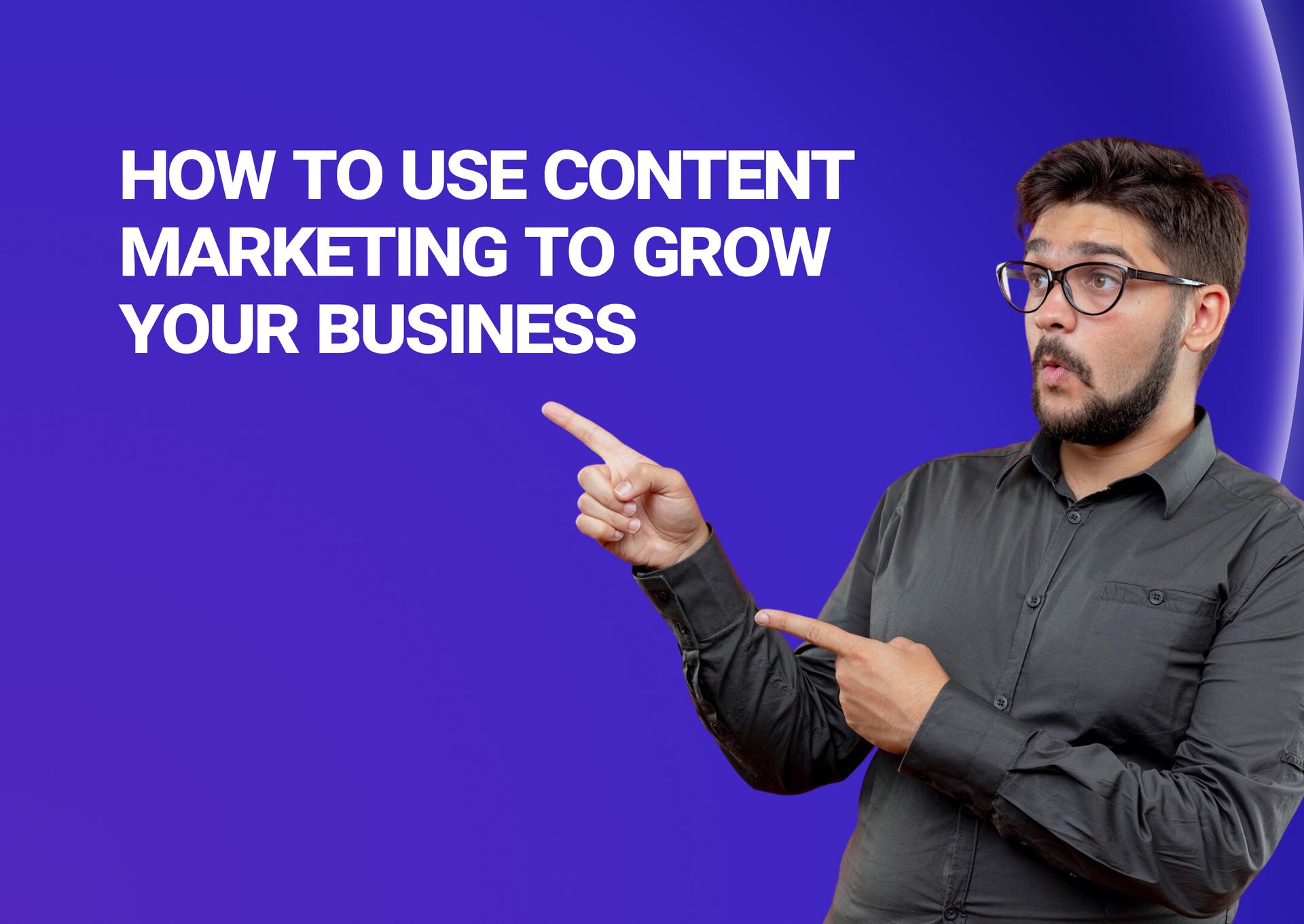Did you know around half of all B2B marketers say content marketing is actually their most effective revenue-building strategy? That goes to show just how powerful content marketing can be. That’s not just for awareness, but for your bottom line, too.
If you’re one of the small businesses that hasn’t yet developed a solid content marketing strategy, it’s time to get started. Content marketing has the power to totally transform your:
- Brand awareness
- Brand authority
- Customer loyalty
- Conversions
- Retention rates
- Revenue
All of that equals business growth. But here’s the thing: you have to get it right. Spend months trialing strategies and experimenting without direction and you could end up wasting your whole marketing budget.
Instead, listen to what the experts have to say. We’re going to tell you exactly how to use content marketing to grow your business in today’s guide. We’ll explore the importance of goals and audience analysis, as well as where different content formats shine and how to measure your content marketing performance.
- Set the Right Goals (Aligned with Funnel Stages)
- Understand Your Target Audience Deeply
- Choose Your Content Pillars
- Pick the Right Content Formats That Drive Results
- SEO + Content = The Growth Engine
- The 80/20 Rule of Content Promotion
- Organic Distribution Channels That Scale
- Paid Content Promotion (When and How to Use It)
- Influencer and Partner Distribution
- How to Measure Performance & ROI
- How to Scale Your Content Operations
- The Bottom Line
Set the Right Goals (Aligned with Funnel Stages)
We see too many first-timers setting out on their content marketing journey without a single goal to direct them. Without goals, you’ll end up wasting money on unfocused content that doesn’t convert.
It’s crucial to understand how your content fits into your funnel stages. Here’s what we mean:
TOFU (Top of Funnel)
Here, the goal is to attract and educate leads unfamiliar with your brand. That usually means content has to be educational or entertaining and highly SEO-focused for discoverability. Examples would include:
- Blog posts
- Social media content
- Educational videos
- Podcasts
- Guides
MOFU (Middle of Funnel)
At the middle of the funnel, you need to nurture leads and build trust, and show why your solution is the best one. So, content should be solution-oriented and valuable. Example might include:
- In-depth guides or books
- Case studies
- Webinars
- Email newsletters
- Product demo videos
BOFU (Bottom of Funnel)
The goal here is simple: to convert high-potential leads. They’re ready to buy, but they’re still looking for that extra assurance/incentive. You should be offering persuasive content that leads can’t resist:
- Free trials or product demos
- Customer testimonials
- ROI calculators
- Product datasheets
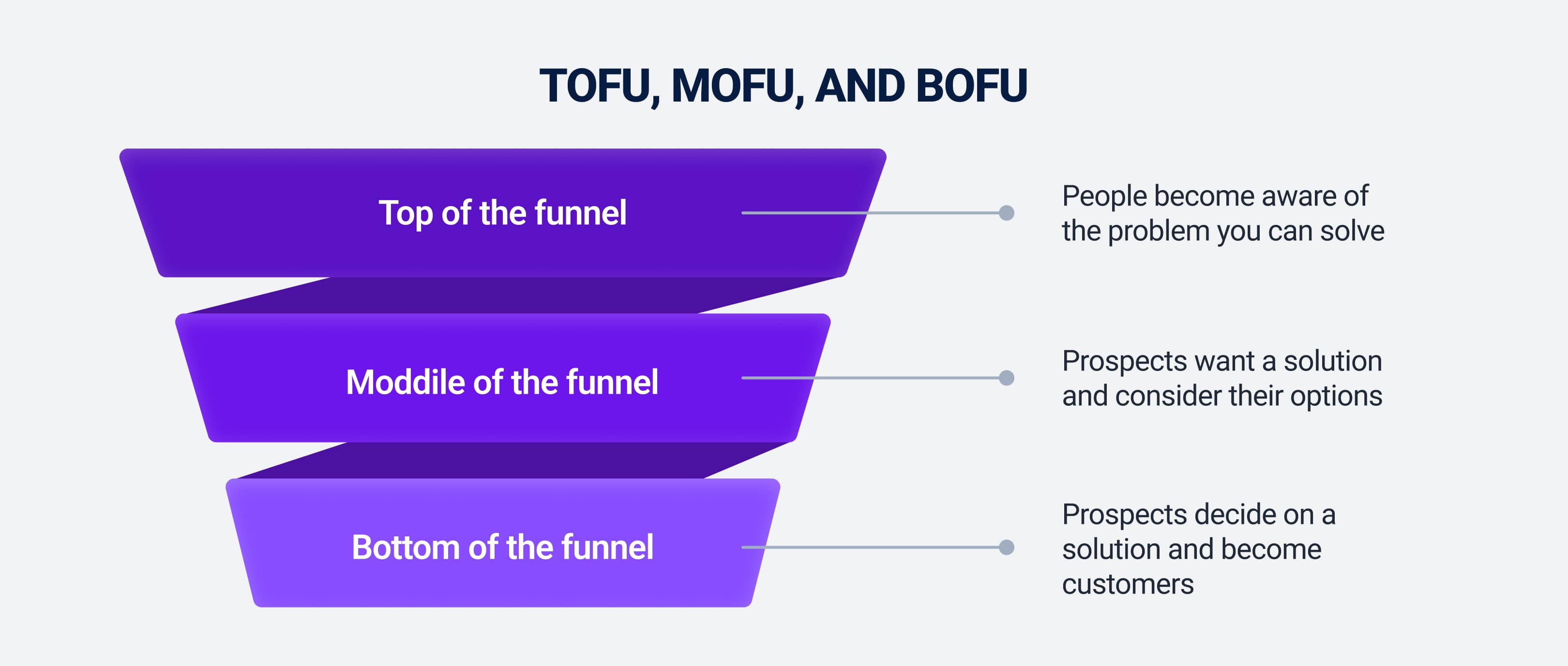
Understand Your Target Audience Deeply
If you’re going to offer leads content they can’t resist, you’re going to have to understand them at a much deeper level. That means going beyond demographics and job titles.
To start with, analyze your existing customers and content. Consider aspects like traffic sources and time on page, as well as heatmaps. You could even survey your audience on your site or via email. Keep it short and unintrusive, though.
From there, you should develop your ICP and buyer personas:
- ICP - identify the types of customers who are most valuable. Think about firmographics (industry, company size, revenue, job titles), demographics (age, gender, location, income, education), and psychographics (values, interests, lifestyles, personality).
- Buyer personas - now, create a detailed, semi-fictional profile based on your data. Include things like the character’s background and their goals and aspirations, as well as objections to buying and buying triggers.
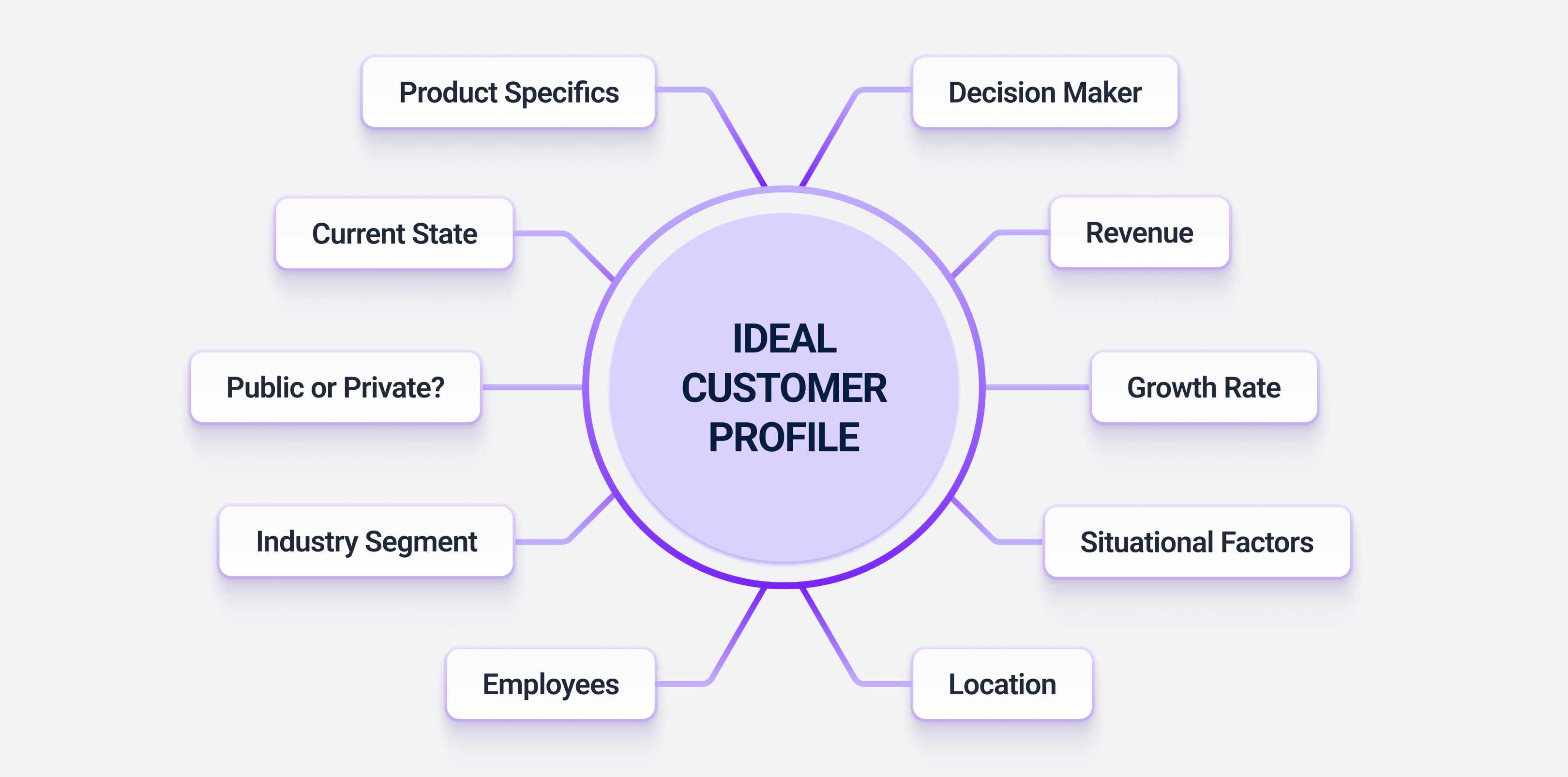
Choose Your Content Pillars
High-conversion content is high-focus content. In order to achieve that focus, you’ll need to spell out some content pillars (core content themes or topics) that prop up your overall content strategy. These are the key areas of expertise or value that your brand consistently creates content around.
Pillars should be focused but broad enough to support subtopics. This way, you can:
- Stay strategically focused
- Build authority and SEO
- Serve different buyer personas/funnel stages
Let’s explore an example:
Let’s say you’re a B2B CRM company. You content pillars might be:
- Sales Process Optimization
- Customer Relationship Management Strategies
- CRM Software Features & Integrations
- Lead Generation & Nurturing
- Customer Retention & Loyalty
From there, it’s much easier to brainstorm content within those umbrellas. For example, a blog post on “How to Shorten Your Sales Cycle” under “Sales Process Optimization”.
Pick the Right Content Formats That Drive Results
Not every content type has the same value in every scenario. If you’re going to perfectly align your content with both your and your audience’s needs, you should get to know your content formats:
Blog Content (Not Dead, Just Misused)
Many businesses mistakenly assume that long-form written content is dead and buried. That couldn’t be further from the truth. True, blog content needs to be sharp and engaging, but you shouldn’t abandon it entirely.
Evidence shows that businesses with blogs generate 67% more leads and are 13% more likely to reach a positive ROI. Why? Great blogging means great organic discoverability (SEO) and more indexed pages.
However, you have to get your blog right. Avoid mass-producing AI blog posts for the sole purpose of SEO. Google actually penalizes this type of content. Instead, focus on producing authentic, valuable content that actually helps the audience.
Video Content (Short-Form vs Long-Form)
Businesses have a lot of options when it comes to video marketing in 2025. TikTok, Reels, and YouTube have a combined usership of 5 billion people! However, if you’re going to stand out with your target audience, your content will have to be both focused and engaging.
You have two main options regarding video content formats: long-form and short-form. Here’s where each shines:
- Short-form - short-form videos (TikToks, Reels) are great for grabbing attention and building awareness. They’re ideal for TOFU marketing.
- Long-form - longer videos give you time to expand on ideas and give detailed insights on your product/service. That would lean more toward MOFU and BOFU content marketing.
Watch this video for a full breakdown of long-form vs short-form video marketing:
Email Content (The Forgotten Sales Machine)
As this graph shows, even in 2025, email is still one of the highest-ROI marketing channels there is. That’s because email marketing doesn’t have to mean irritating spam that ends up in the trash.
Email content marketing is actually one of the most versatile and effective channels at your disposal. It’s ideal for:
- Lead nurturing after initial contact
- Delivering gated content
- Promoting new content or offers
- Customer onboarding and education
- Re-engaging inactive leads or customers
- Product announcements or updates
- Event promotion and follow-up
The key advantage email has is that you can personalize your content marketing. Personalization, as a general rule, can result in a 10-15% revenue lift!
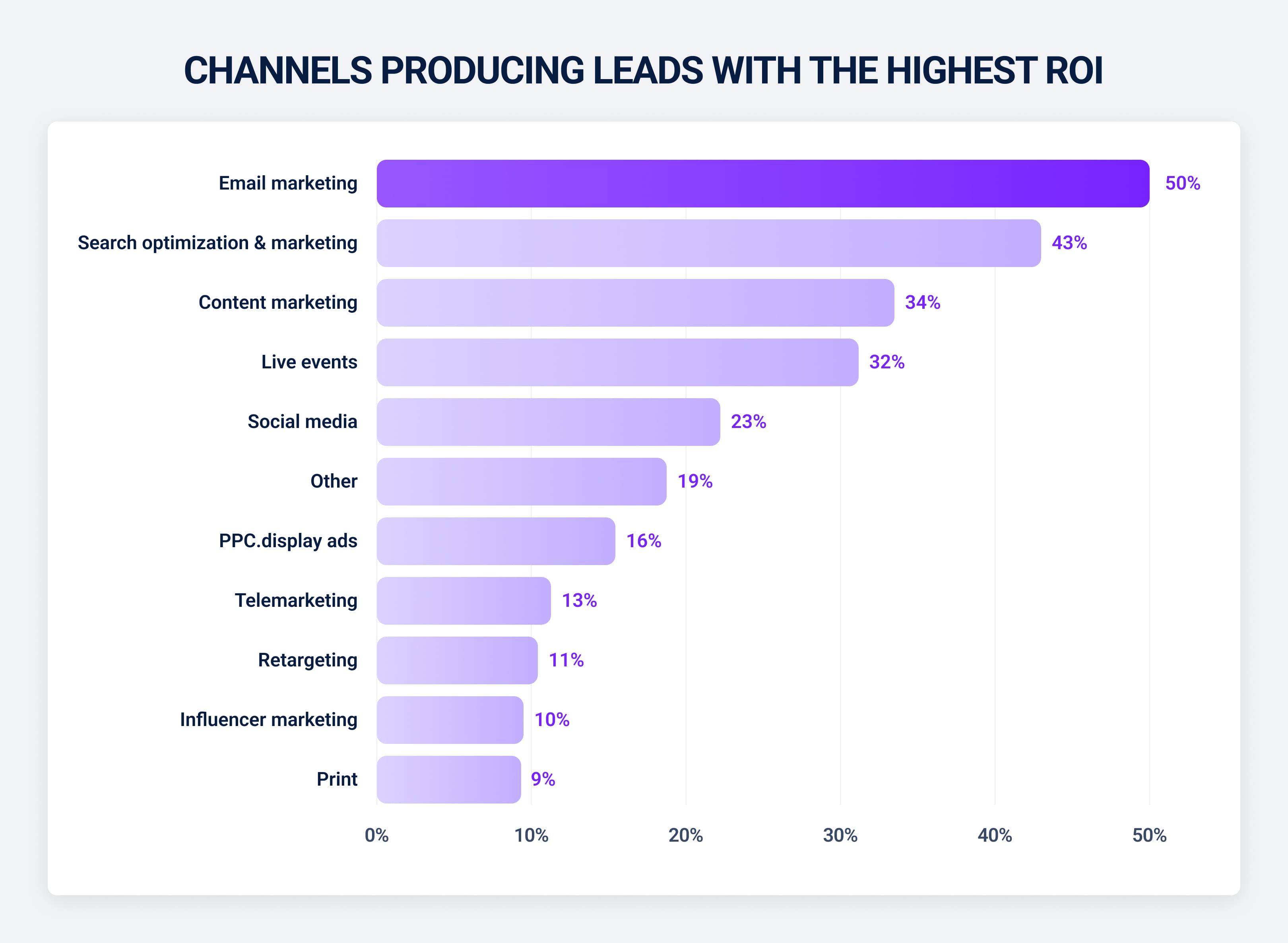
Podcasts, Webinars & Live Streams
Podcast clips go viral all the time. However, it’s not a good content marketing strategy to “try to go viral” (remember, you should always focus on providing value).
Longer-form, non-text content like podcasts and webinars are actually much better suited to MOFU and BOFU marketing. At this stage, leads are weighing up their options and learning about different solutions.
Podcasts and webinars give you the perfect opportunity to explore the buyer’s pain points and your solution in more depth. In many cases, this format will be more effective than a blog guide as most consumers now prefer video content.
Interactive Content, Tools, and Calculators
The great thing about interactive content is that it’s highly useful to the audience and it can actually be leveraged at every stage of the funnel. Providing something like a free ROI calculator is a great way of “giving” the customer something for free (even though it doesn’t cost you anything to run).
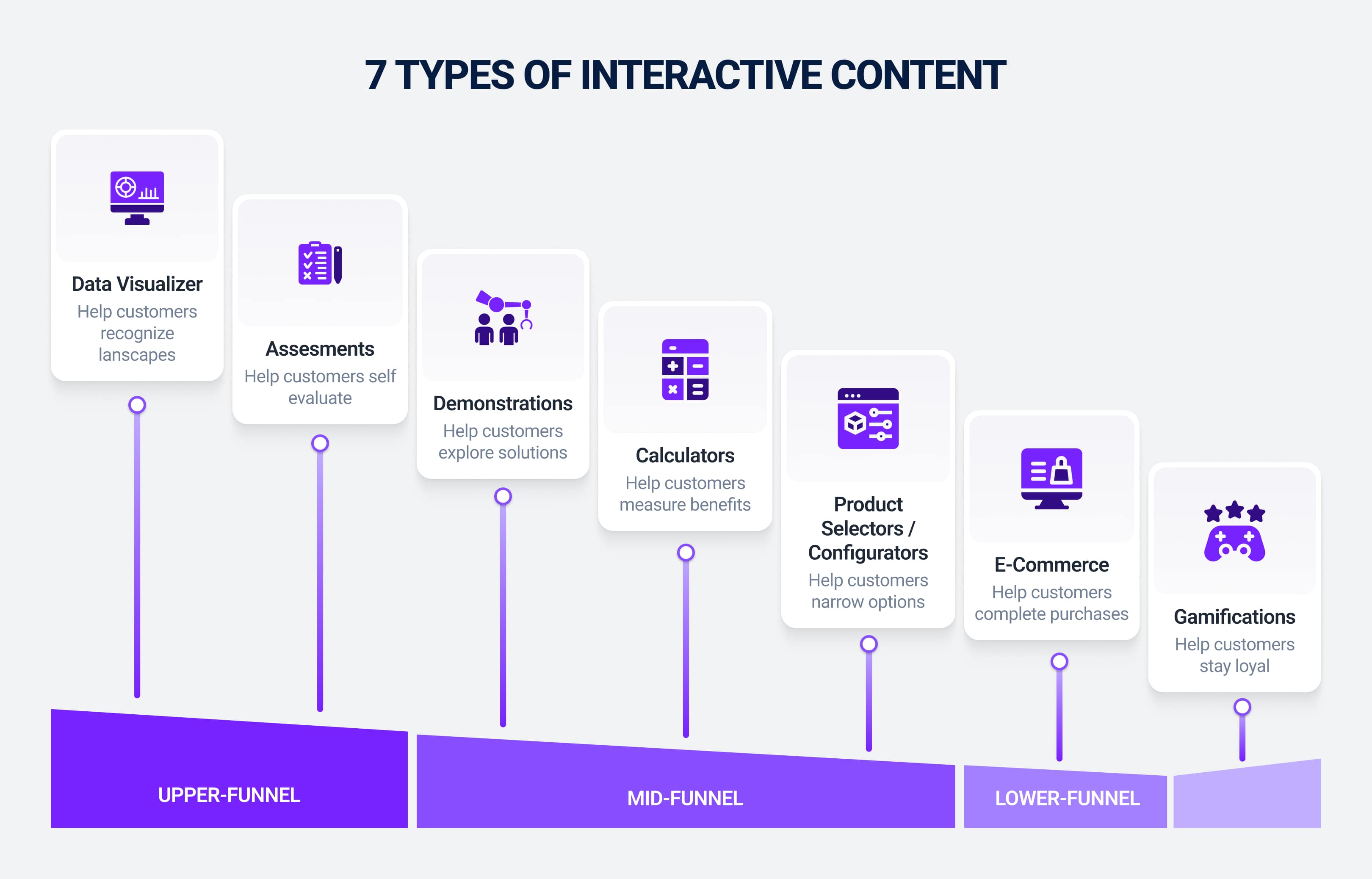
Generally, interactive tools and calculators are at home in the middle of the funnel as this is where leads are exploring their options and still “discovering” your brand.
That said, they can also be a very simple way of nabbing TOFU searches with smart SEO. Likewise, some tools, like product comparison charts, can help toward the BOFU, where customers are almost ready to “jump”
SEO + Content = The Growth Engine
Content isn’t enough on its own. To attract the right audience to it, and convert that audience into customers, you also need killer SEO strategies.
SEO (Search Engine Optimization) is the process of optimizing content so it appears higher in search engine rankings. Top spots mean top leads.
Key “SEO = content” tactics include:
- Keyword research - use tools like Ahrefs to find high-intent, low-competition terms that rank.
- Content clusters - this is where internal linking comes in. Create topic authority by building content clusters within your domain.
- On-page SEO - make sure to optimize all title tags, meta descriptions, headings, alt text, and internal links.
- Technical SEO - you should also test for fast load times and mobile friendliness for best SEO results.
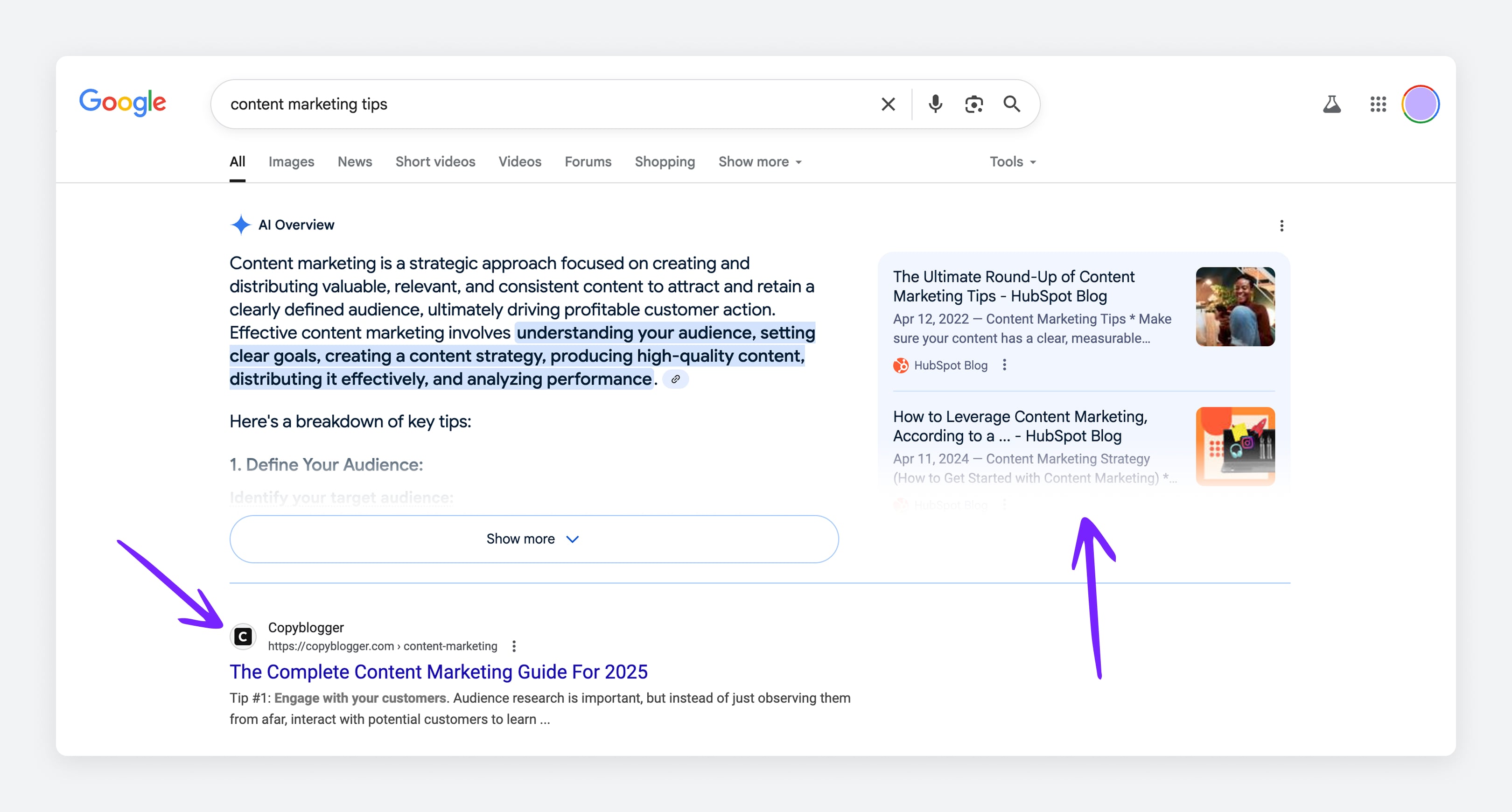
The 80/20 Rule of Content Promotion
You might know this as the “Pareto Principle”. This is a content marketing “rule” that suggests 20% of your effort should go into content creation and 80% into promotion. In other words, your shiny new content is useless if no one sees it.
Promoting your content doesn’t have to mean spamming email folders. You have plenty of options when it comes to promoting content. Try:
- Outreach - get in touch with relevant websites and influencers who could benefit from sharing your content.
- Community sharing - post in LinkedIn groups, Reddit, Slack communities, or niche forums.
- Internal linking - don’t forget that you can actually drive traffic to new content by linking from related high-performing pages you’ve already posted.
Content repurposing is another major point here. You can easily 10x the value of a piece of content by reformatting it for other channels. For example, you could turn a blog post into a video series or a podcast episode!
GROW YOUR INSTAGRAM FOLLOWING VIA OUR CELEBRITY CAMPAIGNS
Leverage the power of the worlds A-list celebrities to grow your Instagram every month
VIEW CAMPAIGNSOrganic Distribution Channels That Scale
Once you have your polished content, you’re going to want organic distribution channels you can rely on not only to reach viewers, but which also allow easy scaling in the future.
Here are the top scalable organic channels we recommend:
- Google (SEO) - of course, the top organic traffic-driver is Google itself. Great for evergreen content.
- Email newsletters - ideal for seasonal or “temporary” content like roundups or drip sequences.
- YouTube - it takes time to build an audience, but YouTube is still the best video-sharing platform out there.
- LinkedIn - content marketing for B2B? LinkedIn is the place. Great for developing thought leadership through consistent sharing.
- Republishing - consider repurposing your website blog posts for platforms like Medium or Substack to cast a wider net (never copy and paste the exact same article, however).
Don’t have time to repurpose and distribute everywhere you’d like to? Many businesses choose to automate distribution through systems like Zapier. It can take some getting used to, but once perfected, it can shave off many valuable hours!
Paid Content Promotion (When and How to Use It)
Organic distribution is a must. However, paid content promotion (paid ads) still have their place. Almost three quarters of all B2C marketers use paid promotion. Almost half say their paid content distribution budget is increasing, too:
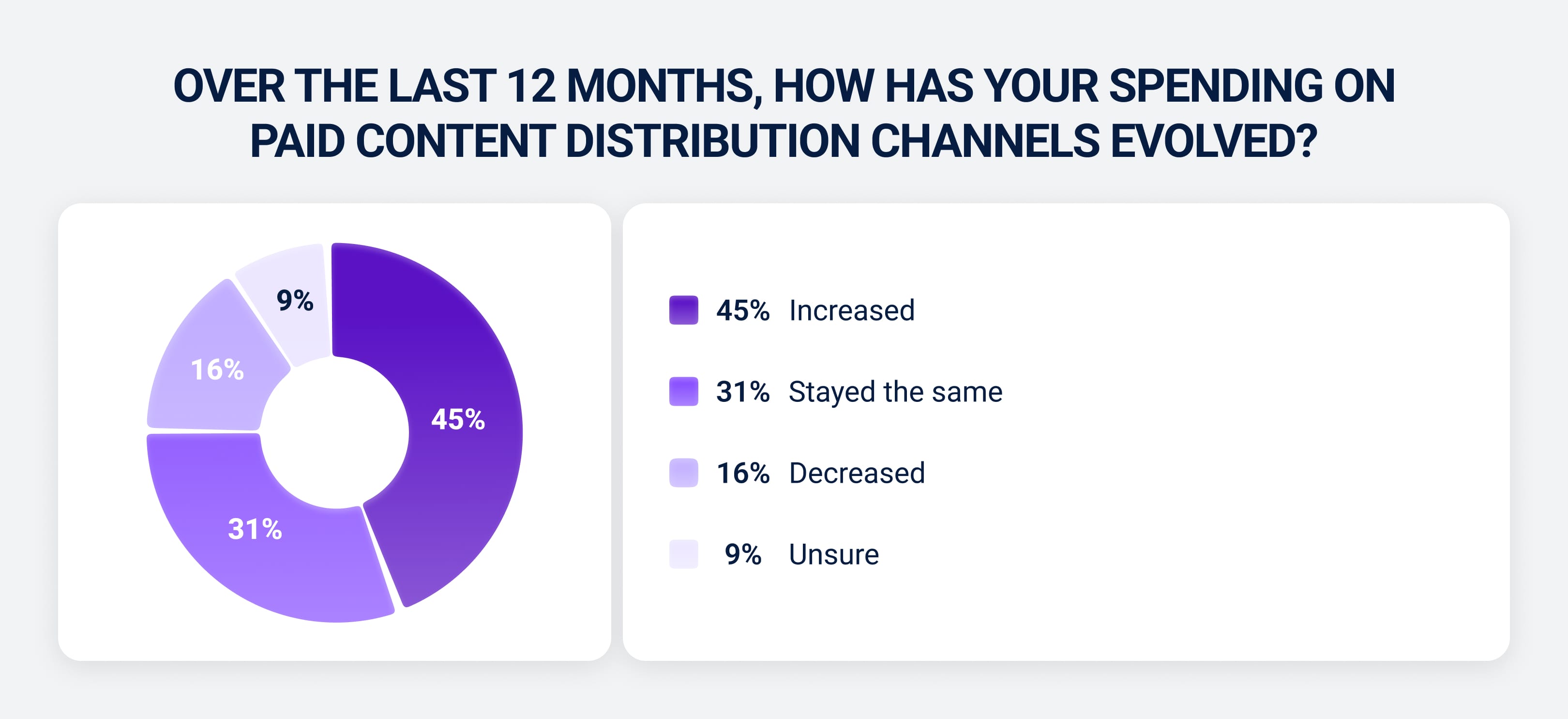
However, paid promotion is best used in certain circumstances. We recommend considering it for:
- Launching a new content asset
- Promoting high-converting or evergreen content
- Retargeting people who visited but didn’t convert
- Scaling what's already working organically
Google is still the top platform to invest in PPC ads. However, content marketers have many options, each with their own strengths depending on your audience:
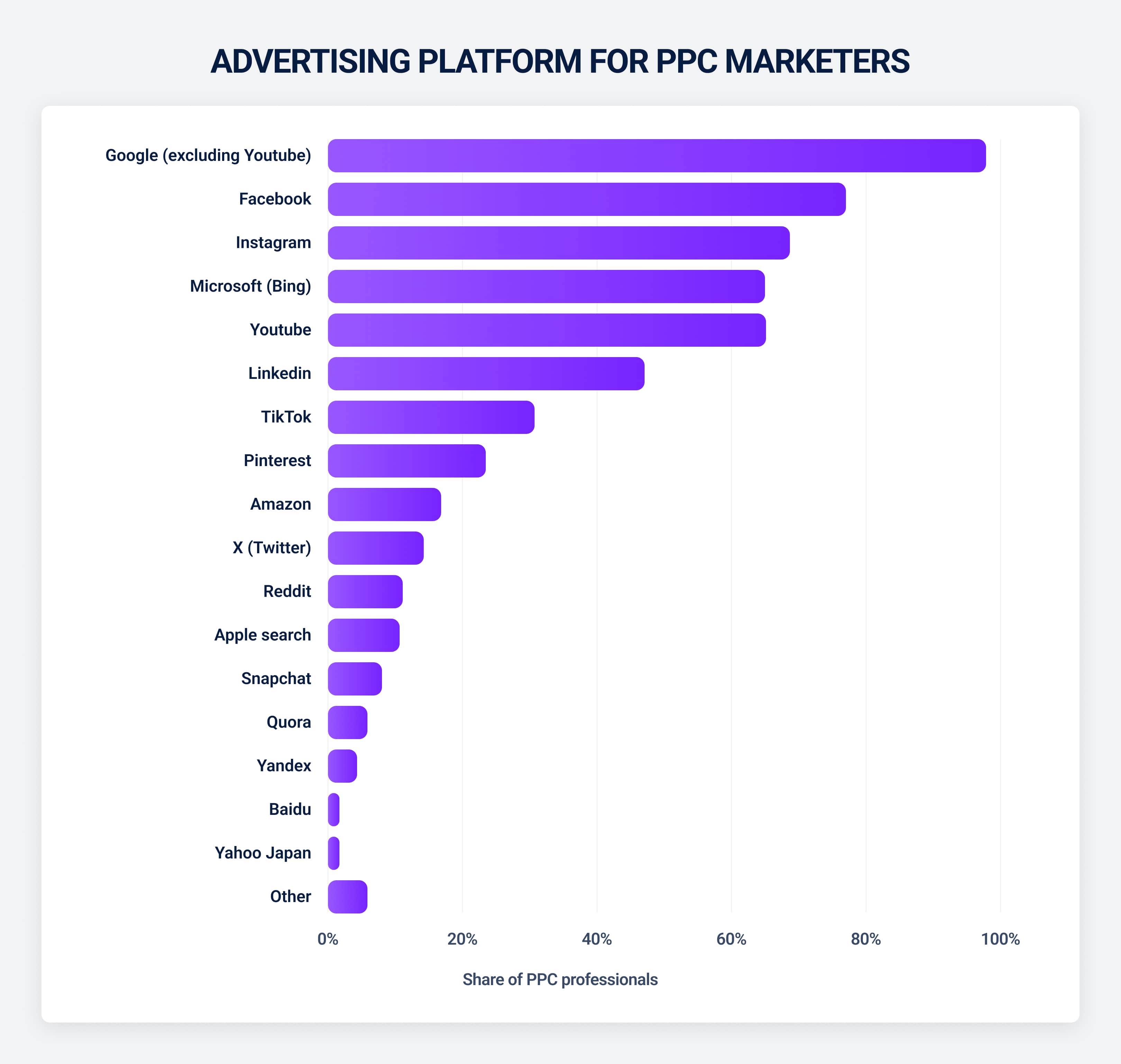
Wherever you advertise, make sure you’re using a powerful CTA and monitoring key metrics like cost per lead (CPL) or cost per content engagement (CPE).
Influencer and Partner Distribution
Successful influencers already have loyal audiences, so it’s a great opportunity to match your brand with a niche and amplify your voice.
Here are some proven influencer/partnership content marketing tactics to try:
- Expert roundups - invite 5-10 experts to contribute short quotes about your product/service.
- Co-branding - collaborate with complementary brands or partners to create joint content (webinars or eBooks, for instance) that capture both audiences.
- Micro-influencer campaigns - you don’t have to target big names with huge followings. Micro-influencers (with under 50k followers) in your niche can work wonders. Reach out to them for product reviews or tutorials!
- Cross-posting - offer a guest blog on a partner’s site, republish your post with a backlink, share each other’s newsletters.
- Affiliate programs - create cool incentives for your partners to become promoters/ambassadors for your brand.
Here are some best practices to get the most out of your influencer collaboration:
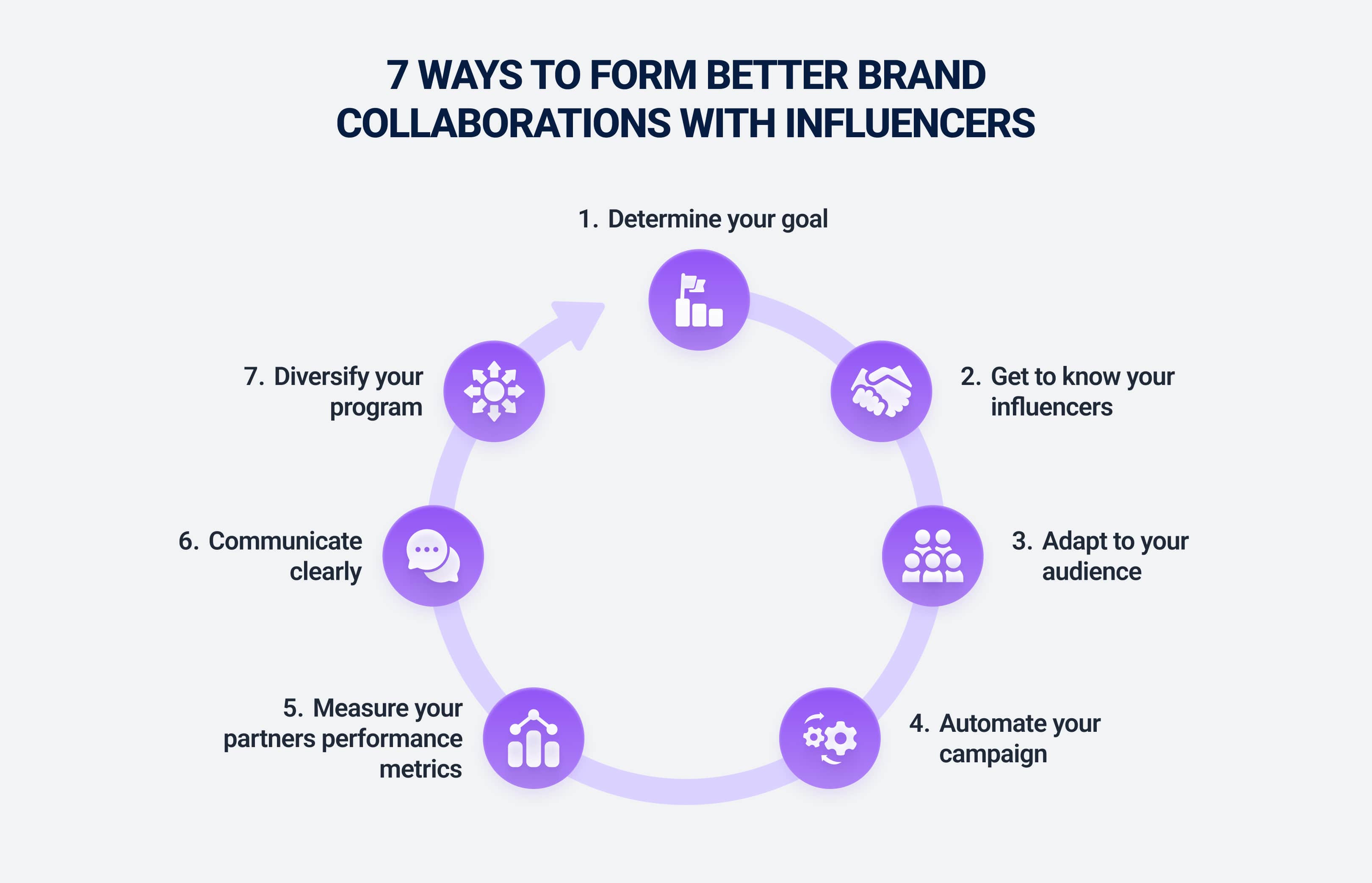
How to Measure Performance & ROI
Monitoring your content is as important as distributing it. You need to know what’s working and what isn’t so you can replicate success and ultimately grow your business.
However, it’s not as simple as counting conversions. The KPIs you monitor should be different at different stages to reflect your needs:
- TOFU - focus on web traffic and click-through rate (CTR) to see how well you’re grabbing attention.
- MOFU - turn your attention to metrics like time-on-page and signups to track interest in your content.
- BOFU - here’s where conversions and sales really matter.
You should also use tools like GA4 and HubSpot to visualize your results. It’s far easier to digest a graph than a spreadsheet packed with numbers!

We also recommend using UTM (Urchin Tracking Module) tracking on each and every campaign. This method uses parameters (or tags) at the end of a URL to track campaign performance. It shows you how visitors got to your content. Here’s a step-by-step guide:
- Use a UTM builder - Google offers a handy Campaign URL Builder for just this purpose.
- Fill in the UTM parameters - figure out what exactly you want to track with different parameters:
- utm_source = where the traffic is coming from
- utm_medium = the channel type
- utm_campaign = the campaign name
- Add UTM - tagged links to your content - use the generated URLs in your campaign content.
- Test your links - make sure you click on every link and make sure everything works the way it should.
- Monitor performance - head to GA4 and go to Reports > Acquisition > Traffic acquisition.
You’ll also need to attribute revenue to content. You need to know which pieces are driving real business impact. Here are the common attribution models:
- First-touch - 100% of the revenue credit goes to the first interaction a user had with your brand.
- Last-touch - 100% of the revenue credit goes to the last interaction before conversion.
- Multi-touch - Revenue is split across multiple touchpoints throughout the buyer journey.
Analyzing touchpoints tells you exactly where content is succeeding in each funnel stage.
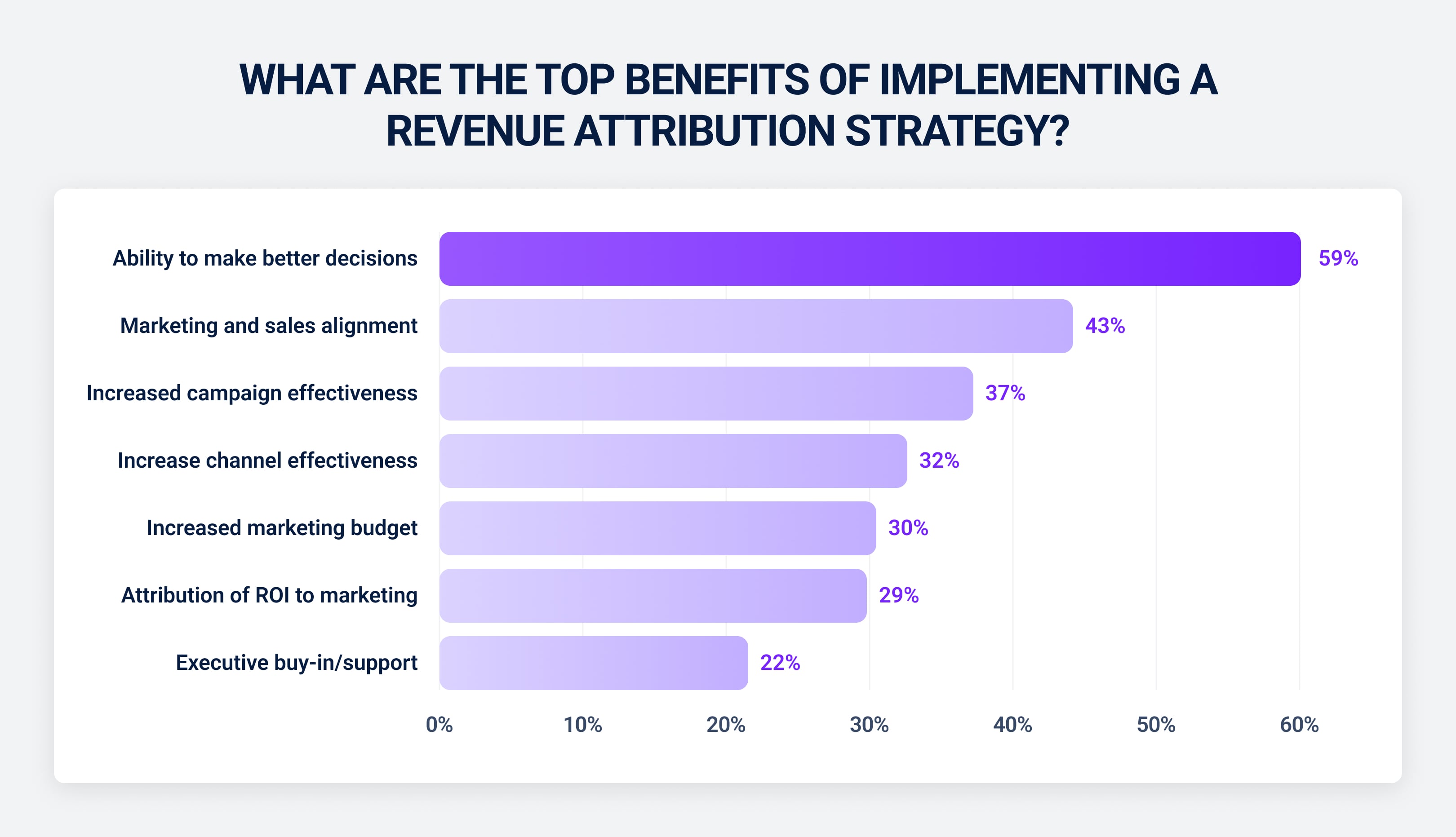
How to Scale Your Content Operations
You don’t just need to be able to create stellar content. You need to be able to scale that strategy for sustained success. Take a step back from your content marketing strategy and consider how you might grow:
Build a Content Team That Delivers
Every successful content campaign rests on the shoulders of specialized roles that work in sync. You’ll need at least some of these to scale at pace:
- Content strategist - to set the direction of travel.
- Content writers - to create your incredible content.
- Editors - to make sure TOV and facts are up-to-date.
- Designers - to create stunning visuals.
- Video editors - to keep your video content fresh and exciting.
- SEO specialists - to make sure you’re hitting the SEO nail on the head.
In-House vs Outsourced vs Hybrid Content Marketing Models
You don’t necessarily have to carry out your content marketing strategy alone. More and more companies are choosing to outsource their content marketing activities as a way of saving money and guaranteeing the best possible expertise.
Here are the pros and cons of each model:
- In-house team - in-house teams offer tight brand control and fast iteration. However, they can be very expensive to build and maintain and there’s a much longer hiring ramp-up.
- Outsourced team - an external team might not automatically be as immersed in your brand as an in-house team. However, the right content marketing agency will spend time getting to know you. Plus, it’s often more affordable and scalable in the long-run.
- Hybrid model - you might choose to retain an in-house content leadership team while outsourcing the actual content creation and distribution to a third party. This works extremely well for many businesses!
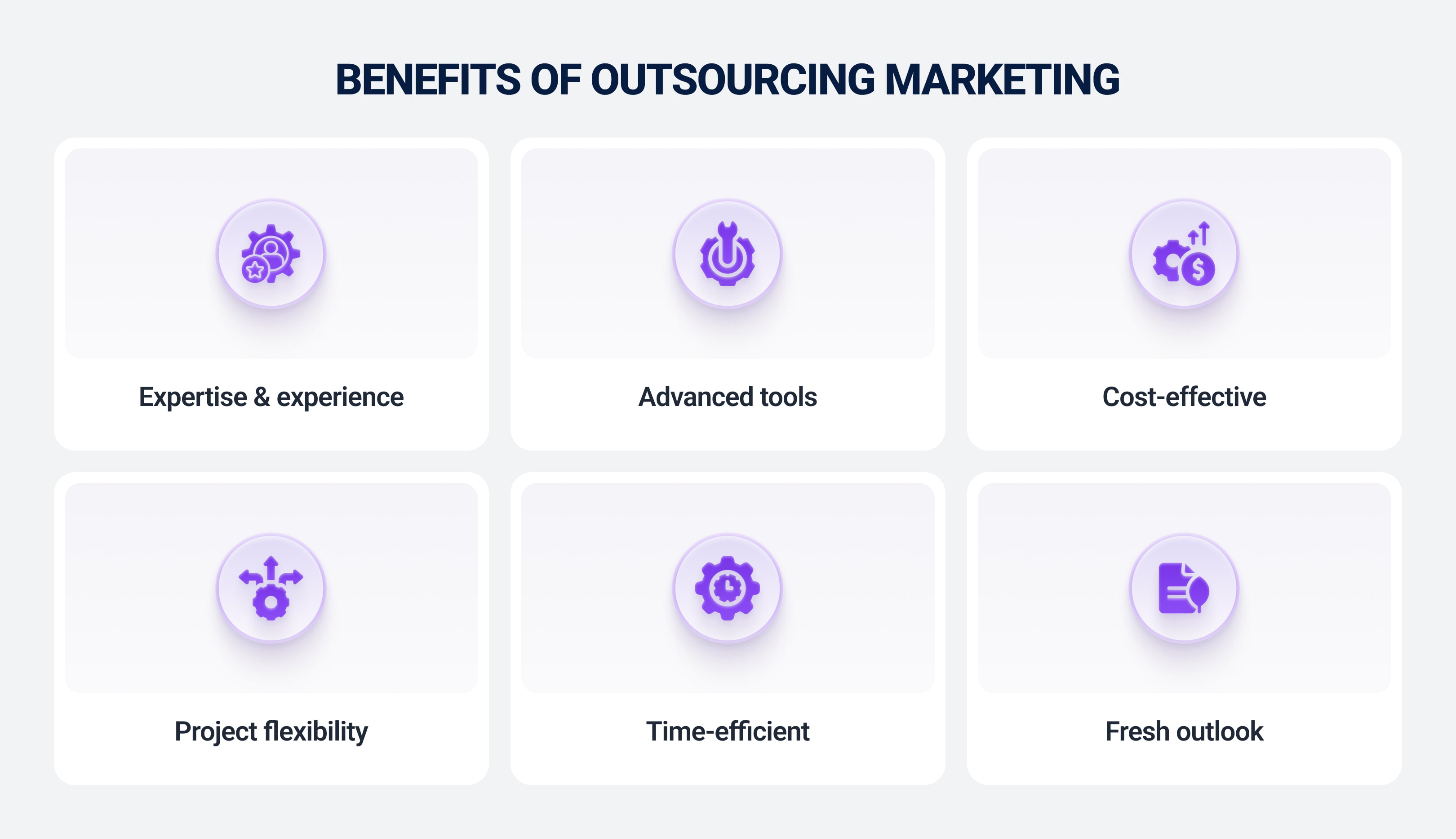
Editorial Systems, SOPs, and Automation
Standardizing your content workflow hugely speeds up your process. That starts with developing a managed editorial system with regular meetings and clear workflow stages such as ideation, assignment, drafting, editing, designing, and so on.
Within those stages, you should also make every process as streamlined as possible. For example, it’s a good idea to produce standardized content briefs that follow the same, recognizable template.
Once you’ve got the hang of your content workflow, you should also develop and document clear SOPs (Standard Operating Procedures). This involves documenting repeatable processes for:
- Blog writing + editing
- SEO
- Video scripting
- Design handoffs
- Distribution and promotion
Automation can play a big role in content marketing, too. AI/automation tools cut down the time you spend manually completing repetitive tasks and the costs associated with them. We’d recommend looking into:
- Auto-creating tasks with tools like Zapier.
- Auto-scheduling posts with Buffer.
- Auto-tagging content in analytics platforms.
The Bottom Line
Content marketing should be a major part of your marketing strategy if it isn’t already. Consumers today want high-quality, reliable content that educates them, not just ads. Content marketing is your opportunity to stand out from the crowd and draw customers in with thought leadership.
However, you have to get it right. If you want to know how to use content marketing to grow your business, you need to start with a solid process. Eliminate guesswork. Conduct deep research into your audience and decide on the kind of content (and which channels) suit you best.
SOPs are also key. Create clear, actionable documents that outline successful content processes and educate your team on using them.
Developing reliable content marketing in house can be a huge undertaking. Many businesses choose to outsource content marketing to trusted agencies like Influize. Instead of starting from scratch and waiting months until you see results, businesses like yours can “plug in” to an experienced content marketing team that understands your needs and knows how to get results.
Frequently Asked Questions
What’s the ideal content budget for a small business?
It varies by business and industry but generally 5-15% of your marketing budget is a good starting point. Start lean. Prioritize high-impact formats like blog posts and videos then scale as ROI becomes measurable.
Should I create content in-house or hire a content agency?
For high control and brand alignment, in-house wins out. However, it’s expensive. It’s often cheaper and quicker for small businesses to outsource content marketing to an experienced agency like Influize.
How do I use content to position my brand as an industry expert?
Focus on educating, not selling. Publish insight-driven content that answers key questions your audience has. Try to also include things like expert roundups to build authority and credibility.
What’s the most efficient way to turn content into leads?
Create gated content your audience can’t resist like eBooks and webinars. Use clear CTAs and lead capture forms, then nurture those leads with email sequences or retargeting.
How do I track which content converts best?
UTM parameters and GA4 should be central to your content tracking. These approaches show you exactly what converts and why so you can better identify what drives revenue or qualified leads.
